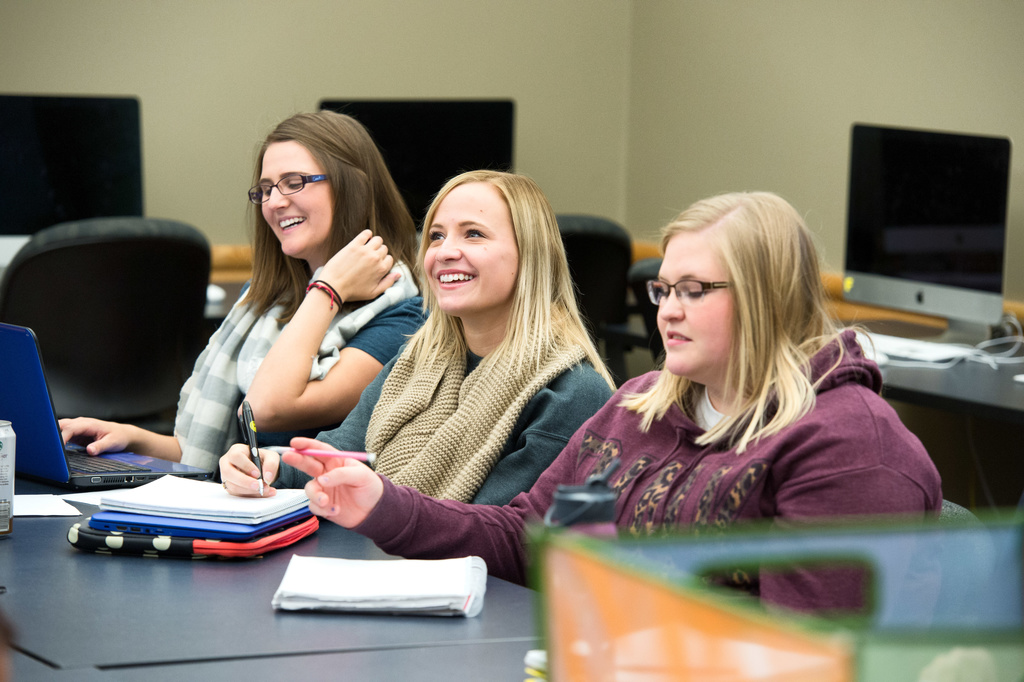"All semester, we've been looking at how nonprofit organizations communicate with their supporters. Tonight it's direct mail—all the stuff you get asking you to give dollars to all sorts of things."
And with that, Fundraising and Philanthropy Communication (FPC:3185) begins. Thirteen students seated around a table in room W236 in the Adler Journalism and Mass Communication Building start taking notes—on paper and laptops—while Ann Haugland, lecturer in the University of Iowa’s School of Journalism & Mass Communication (SJMC), leads the discussion.
“So, what are the components that go into the actual appeal to potential donors?” asks Haugland.
The nearly three-hour, weekly class gives students a chance to learn about nonprofit organization branding and donor communication and gain practical experience planning and writing fundraising materials. It’s also a core course in the Fundraising and Philanthropy Communication certificate program.
The certificate, administered by the SJMC in the College of Liberal Arts and Sciences, gives students of all majors the opportunity to prepare for careers—and leadership roles—in the growing field of nonprofit organizations. In fact, according to the Bureau of Labor Statistics, jobs in advocacy, grantmaking, and civic organizations are projected to increase 14 percent by 2018, compared to 11 percent overall job growth. Jobs requiring communication and fundraising skills are expected to grow even faster.
“We have two goals: One is to prepare students to be very strong candidates for beginning-level jobs in this field,” says Haugland, who is also coordinator of the Fundraising and Philanthropy Communication certificate program. “The other is for students to have a better sense of the role that private dollars have in an awful lot of things.”

Since the program started in 2011, more than 80 students have graduated with a Fundraising and Philanthropy Communication certificate. A generous gift from a donor’s family was instrumental in creating the certificate, one of the few undergraduate philanthropy studies programs in the nation and perhaps the only one associated with a journalism school.
Students like Jamie Gurgul and Tess Zernhelt say they know how important effective communication is, whether reaching out to potential donors or clients. Both Gurgul and Zernhelt are on track to graduate in May with the certificate, and look forward to taking what they learn inside the classroom and applying it at a nonprofit.
“I like the written communication part,” says Gurgul, a senior majoring in journalism and mass communication from Spring Grove, Illinois. “You get a little more of a creative aspect, which helps you be a little more innovative when you get out in the real world—it’s more applicable.”
“We learn about physical communication in my speech and hearing science classes, but not how to relay communication,” says Zernhelt, a senior majoring in speech and hearing science from Johnston, Iowa. “It’s great to learn strong communication skills with donors, and I also like the creative aspect.”
As for Haugland, she’s excited to continue teaching students like Zernhelt and Gurgul and to see them join other students with the certificate who are already in workforce, currently working everywhere from the UI Foundation to the Domestic Violence Intervention Program in Iowa City, or attending graduate school.
“I’m really, really proud because I think we give them that little leg up they need,” says Haugland. “It’s kind of a professional orientation. They learn some of the basic concepts and skills so that they can do really well in job interviews, and then they’re ready to hit the ground running.”